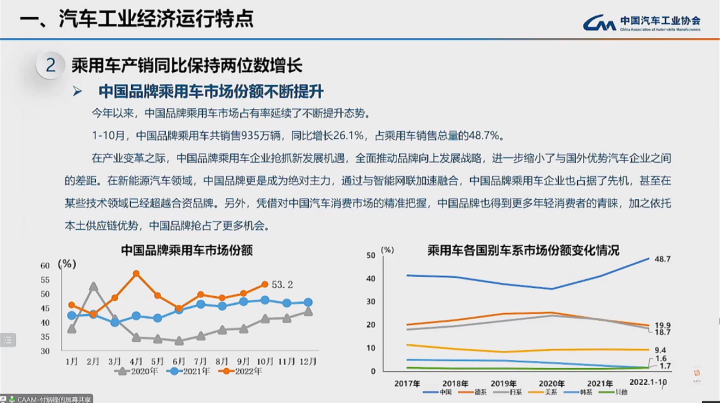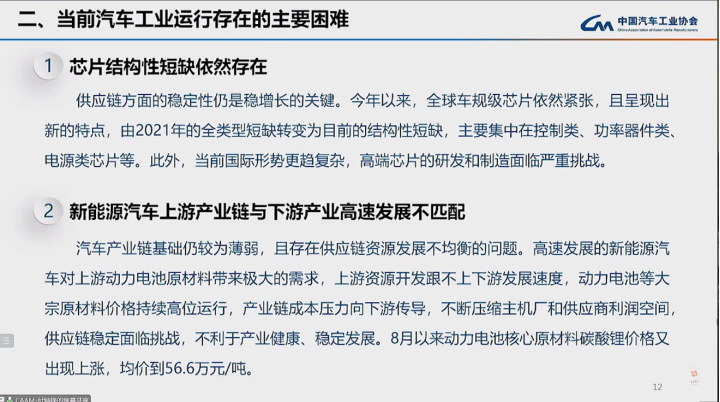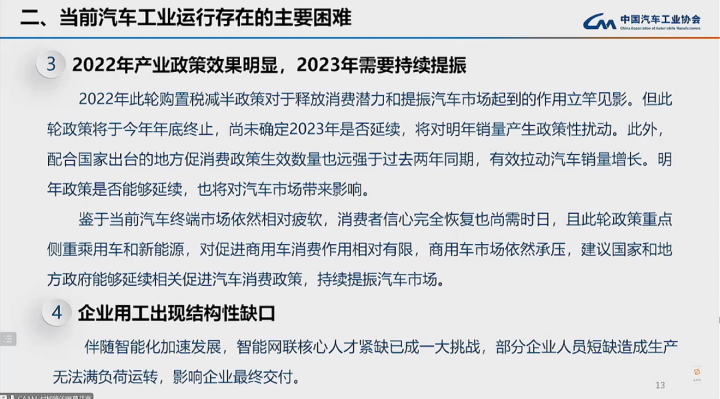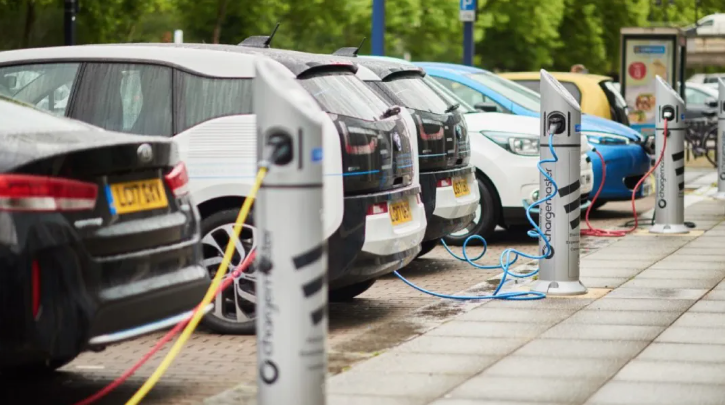Author: Wang Lingfang
Editor: Qiu Kaijun
“In my personal opinion, the chip shortage is not accidental. There may be natural factors, but it has caused such a great impact on the Chinese market. There must be reasons other than man-made and diplomatic reasons. The industry chain has a phenomenon of reaping the benefits. We can wait and see. Perhaps we will be able to see in 1-2 years.”
This was mentioned by Fu Bingfeng, Executive Vice Chairman and Secretary General of China Association of Automobile Manufacturers, during the “2022 China New Energy Vehicle Big Data Industry Summit” on November 13th.
Fu Bingfeng summarized the achievements and difficulties of the automobile industry’s development.
In terms of achievements, from January to October, automobile production and sales maintained a growth trend, and production and export of new energy vehicles reached a new high.
Problems are reflected in three aspects: “Firstly, commercial vehicles have always been hovering at a low level; Secondly, although the automobile industry has a good production and wholesale momentum, the terminal growth is weak and the terminal inventory level has increased; Thirdly, it is unclear whether the preferential policy for traditional fuel vehicle purchase tax will be extended next year, the subsidy for new energy vehicles is about to be withdrawn, coupled with the substantial increase in raw material prices of power batteries, there is uncertainty in business expectations and difficulty in formulating business plans. Macro-level guidance is urgently needed.”
Regarding the prediction for the new energy vehicle market next year, Fu Bingfeng stated that he had some communication with some mainstream new energy vehicle companies’ strategic and marketing departments. “Everyone generally believes that the forecast for next year should be at a level of around 7-8 million units. It is entirely possible that passenger cars alone exceed 7 million units, and when combined with commercial vehicles, it can reach a level of over 8 million units.”
Characteristics of the Automobile Industry’s Operation
(1) Automobile production and sales maintain a growth momentum on a year-on-year basis
Looking back at the development of China’s automobile industry, from the second half of 2018, automobile sales entered a negative growth state, declining from 28.88 million units to 25.21 million units. Starting from 2021, automobile sales have begun to increase.
Fu Bingfeng believes that this is a normal stage of industrial transformation, upgrading, and adjustment. Consumers may have doubts about old technology products and expectations for new technology products. New energy is also in a critical transitional period.
In recent years, the State Council has timely introduced policies, and under the combined effects of the chip shortage and the pandemic, the automobile industry has still achieved good results.
(2) The market share of Chinese brand passenger cars continues to increase
“In terms of vehicle sales, consumption upgrades are very obvious. The proportion of cars below 100,000 yuan has gradually decreased and concentrated around 150,000 yuan.” In the high-end vehicle field, domestic brands have launched competitive models and have also gained a certain market share.“`markdown

(3)Commercial Vehicle Market Remains Low
In the opinion of Fu Bingfeng, commercial vehicles reached a turning point in 2021, slightly lagging behind passenger cars by two to three years. Its performance has also been affected by the economic situation under the epidemic, coupled with the reduced investment in large projects over the past two years, leading to the low position of commercial vehicles.
Fu Bingfeng believes that commercial vehicles are slow in the process of transitioning to electrification and intelligence.
(4)Exports Reach Record High, Especially for New Energy Vehicles
From January to October, auto companies exported 2.456 million vehicles, an increase of 54.1% YoY. Among them, passenger cars exported 1.975 million vehicles, an increase of 57.1% YoY, and 480,000 commercial vehicles were exported, an increase of 43% YoY. 499,000 new energy vehicles were exported, an increase of 96.7% YoY.
According to Fu Bingfeng, the rapid growth of exports is attributed to a series of factors such as China’s product technology level, customer experience, quality level, and cost control capabilities.
“Of course, not only domestic brands, but also Tesla’s exports have made a significant contribution. This also proves that the cars produced by Tesla in China have cost competitiveness for exports, and our supplier system can support it. Some joint venture brands are also exporting, and our manufacturing capability has been greatly improved. Furthermore, the new technologies of our products are indeed recognized by consumers in the mainstream European automotive countries.”
Main Difficulties in the Operation of the Auto Industry
(1)Shortage of Chips and Raw Materials is Not Simple
According to Fu Bingfeng, this is the last harvest of traditional technology in the process of China’s automobile industry transformation towards electrification and intelligence.
Fu Bingfeng said that the big bosses of the auto companies also feel that the recent price hikes are abnormal. This price increase has a huge impact on the transformation and development of the entire industry. This matter is directly related to the national energy strategy, innovation strategy, low-carbon strategy, and green development strategy. The entire industry is investing heavily around this big strategy. The sudden price surge of chips and lithium battery raw materials at this time is abnormal.

“`Fu Bingfeng stated that when looking at the entire industry, it can be seen that the shortage of chips and raw materials exists, but vehicles are still being produced. In the case of such a shortage of chips, new energy vehicles in China still see double-digit growth each year. Where do the chips come from? Despite the shortage of raw materials, battery production continues as normal, indicating that many abnormal situations exist.
(2) Uncertainty of Policy Continuation Expectations
The halving of the vehicle purchase tax in this round in 2022 has had an immediate effect on unleashing consumption potential and boosting the market. However, this round of policy will end at the end of this year, and it is not yet known whether it will continue in 2023, causing policy disturbances in next year’s sales.
Fu Bingfeng expressed concerns about the continuity of policy currently being a worry for enterprises, causing fluctuations in sales at the end of the year. He hopes that the government department in charge will actively coordinate and make timely decisions.

(3) Structural Labor Shortage in Enterprises
With the epidemic and enterprise transformation, talent shortage in the automotive industry has become a big problem. For example, there is a lack of talent in research and development, and production personnel are not stable, which has a great impact on the development of enterprises.
Fu Bingfeng believes that the next step in the industry’s work focuses mainly on three areas. Firstly, it should focus on constructing a Chinese-style intelligent networked vehicle industry integration ecosystem. Secondly, it should implement the “dual-carbon” strategy. Thirdly, it should establish a new supply chain system.
Regarding the intelligent networked ecosystem, Fu Bingfeng stated that automotive companies are now using both open source and non-open source platforms from abroad for smart driving and intelligent networked cockpit development. “If everyone works individually, then it becomes a many-to-many problem. Your kernel system and hardware below are many-to-many, which makes it difficult for our hardware to cope, and our companies also have to bear huge research and development costs.”
Therefore, the industry needs to build platforms, coordinate with each other, and construct a large ecosystem for the Chinese-style intelligent networked vehicle industry in multiple dimensions.
Regarding the dual-carbon strategy, Fu Bingfeng stated that there is at least a consensus on the multi-technical route, in which pure electric vehicles are the main ones, and multiple technical routes coexist. At the same time, the importance of “dual-carbon” research is in line with international standards, and it integrates into the international cycle. “Our export situation is so good now. If one day we cannot connect with overseas in terms of carbon footprint, it will also impact our complete vehicle exports.”Bingfeng Fu proposed that automotive companies should play a leading role in the upper stream and provide services to the lower stream, while ultimately taking responsibility for recycling.
In terms of constructing a new supply chain system, a thorough study is required regarding supply chain layout, risk, ecology, and innovation. “Currently, major enterprises in each industry serve as chain leaders, and conduct research on supply chain innovation issues, such as bottlenecks and breaking points. We believe that these issues will be addressed more rapidly in the new era, under the guidance of the spirit of the Nineteenth National Congress of the Communist Party of China.”
This article is a translation by ChatGPT of a Chinese report from 42HOW. If you have any questions about it, please email bd@42how.com.
